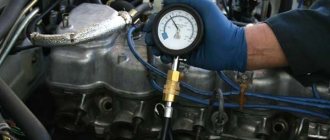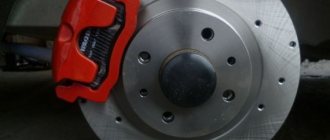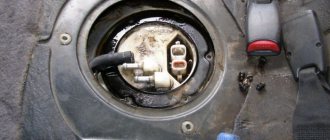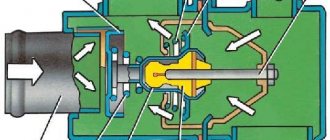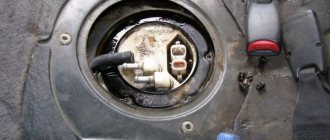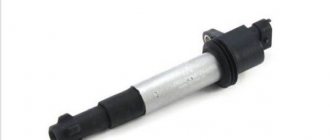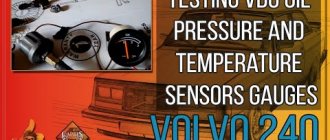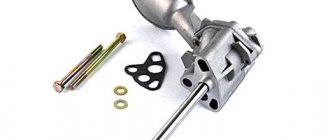Cooling a car is important. The engine cooling system consists of several elements that allow maintaining the required temperature without the threat of destruction of engine parts and mechanisms. The thermostat on the VAZ 2107 is an integral part of the cooling system. The article provides the technical characteristics of this unit, a list of its faults, methods of checking, replacing, and nuances of choice.
The main function and principle of operation of the thermostat on the VAZ 2107
The main task of the thermostat is to prevent the engine temperature from going beyond the specified limits. If the engine heats up above 90°C, the device switches to a special mode that helps cool the engine.
All thermostats on the VAZ 2107 are equipped with three pipes
If the temperature drops below 70°C, the device switches to the second operating mode, which promotes rapid heating of engine parts.
Thermostat device for VAZ 2107.
How does a thermostat work?
The “seven” thermostat is a small cylinder, three pipes extend from it, to which tubes with antifreeze are connected. An inlet tube is connected to the bottom of the thermostat, through which antifreeze from the main radiator enters the device. The antifreeze goes through the tube at the top of the device to the S7 engine, into the cooling jacket.
The central element of the thermostat is the valve
When the driver starts the engine after a long period of inactivity, the valve in the thermostat is in the closed position, so that antifreeze can only circulate in the engine jacket, but cannot enter the main radiator. This is necessary in order to warm up the engine as quickly as possible. And the motor, in turn, will quickly heat up the antifreeze circulating in its jacket. When the antifreeze warms up to a temperature of 90°C, the thermostat valve opens and the antifreeze begins to flow into the main radiator, where it is cooled and sent back to the engine jacket. This is a large circle of antifreeze circulation. And the mode in which antifreeze does not enter the radiator is called a small circulation circle.
What's inside the thermostat
The classic thermostat housing was originally made of brass. Then, different factories at different times produced thermostats with housings made of aluminum alloy and steel. During assembly, a block of two assembled valves is placed inside the two halves of the housing. Then it all gets rolled up and becomes inseparable. The valve block is assembled inside the holder. The rod is fixed motionless. The main and bypass valves can move relative to it, overcoming the force of the springs. On the outside, the housing has three pipes for connection to the water pump (pump), engine and radiator.
1. Inlet pipe (from the engine). 2. Bypass valve. 3. Bypass valve spring. 4. Glass. 5. Rubber insert. 6. Outlet pipe. 7. Main valve spring. 8. Main valve seat. 9. Main valve. 10. Holder. 11. Adjusting nut. 12. Piston. 13. Inlet pipe from the radiator. 14. Filler. 15. Clip. D - fluid inlet from the engine. R - fluid inlet from the radiator. H - liquid outlet to the pump (pump).
Thermostat location
The thermostat on the “seven” is located under the hood, next to the car’s battery. In order to get to the thermostat, the battery will have to be removed, since the shelf on which the battery is installed does not allow you to reach the thermostat pipes. All this is shown in the picture below: the red arrow indicates the thermostat, the blue arrow indicates the battery shelf.
The red arrow shows the thermostat mounted on the pipes. The blue arrow shows the battery shelf
What functions does the thermostat perform on a VAZ 2107?
- When the coolant circulates in a small volume, in a “small circle”, which excludes the radiator and only turns on the interior heater and the engine. In fact, at this stage it is better to warm up the engine as quickly as possible, and circulation of antifreeze in the radiator is simply not needed.
- In this case, the so-called bypass valve is open, and the antifreeze bypasses the radiator.
- When a certain temperature is reached, a large circle opens and liquid begins to flow into the radiator for cooling.
- When the temperature reaches 94 degrees, the thermostat valve on the VAZ 2107 fully opens.
Purpose of the thermostat VAZ 2107 injector
The thermostat is installed at the intersection of the large and small engine cooling circles. This is a temperature-sensitive valve that switches the flow of antifreeze in a small circuit (through the cylinder block), in other words, in a large one (through the radiator, depending on its temperature. The thermostat regulates the nozzles from the pump, engine and radiator. When this problem is solved, the position of the antifreeze from the water pump is directed to the cylinder block, bypassing the radiator, and the fluid in the radiator does not participate in cooling. The freeze of 80-90 degrees the temperature-sensitive element increases, moving the valve cover cover, while a fraction of the antifreeze circulates more paths passing through the radiator. When the engine cools, reverse process, antifreeze circulates through a small circuit
.
Depending on the engine operating mode, temperature and air speed (intensity of air flow to the engine and radiator), the antifreeze temperature fluctuates, and the thermostat opening value changes accordingly. The best operating temperature of the engine is maintained for a given ratio.
VAZ 2107 thermostats differ in design, regardless of engine type, and are a solid cylindrical body with a thermal valve inside. The housing is equipped with 3 nozzles for connecting radiator hoses.
How to get home in such a situation?
Remember that we have another radiator on the Sevens? Although it is small, it may be enough for the return journey without overheating the engine. There is no choice, why not call a tow truck?
- Let the engine cool down as much as possible.
- We open all the windows in the car.
- We start the engine, check that the radiator valve of the cabin heater is open. It is usually closed for the summer.
- Turn on the cabin heater fan. Let it blow on our small stove radiator; we will provide it with some kind of air flow. Open the outside air intake damper.
- Let's start moving.
We stick to a low speed. The motor cannot be revved up too much.
The higher the engine speed, the more often flashes of the air-fuel mixture occur in the cylinders. This means that the heating rate will be greater.
Therefore, we choose the optimal speed mode so that the speed of the power unit does not exceed 2000-2100 (try so hard). This will depend on the design of the fuel system. Below I will tell you how this affects.
We try to slow down with the engine and gearbox
. At this moment, the solenoid valve shuts off the fuel supply to the carburetor. The fuel does not burn, the engine does not heat up.
If the engine speed is above 2000 and the gas pedal is released, the “Forced Idling” system (EFS) comes into operation. This is only the case if the gear is engaged and the clutch pedal is not pressed and you are braking with the engine.
Depending on the design, or more precisely on the control unit of this system, it can be activated when the crankshaft reaches 1900 revolutions and turns off at 1700 revolutions - VAZ 2104,05,07, Lada 2121. Used with a Solex carburetor. By the way, it can also be screwed into Ozone, because the standard pneumatic valve system is unreliable. If you are interested in how to do this, write in the comments. In Ozone, the EPHH turns on at 1600 and turns on at 1200 rpm.
We constantly monitor the engine temperature.
If necessary, we stop and let it cool. But in my case, I am forced to stop only twice while driving through traffic lights. Things were better outside the city.
Signs of a broken thermostat
Since the main main part of the thermostat is the bypass valve, the vast majority of breakdowns are associated with this part. We list the most common symptoms that should make the driver wary:
- The engine overheat indicator light came on on the dashboard. This situation occurs when the central thermostat valve is stuck and is unable to open. As a result, antifreeze cannot go into the radiator and cool down there; it continues to circulate in the engine jacket and eventually boils;
- After a long period of inactivity, the car is very difficult to start (especially in the cold season). The cause of this problem may be that the central thermostat valve is only opening halfway. As a result, part of the antifreeze goes not into the engine jacket, but into the cold radiator. Starting and warming up the engine in such a situation is extremely difficult, since warming up the antifreeze to the standard temperature of 90°C can take a long time;
- damage to the main bypass valve. As you know, the valve in the thermostat is an element sensitive to temperature changes. Inside the valve there is a special industrial wax that expands greatly when heated. The wax container may lose its seal and its contents will spill into the thermostat. This usually happens as a result of strong vibration (for example, if the “seven” engine constantly “trips”). After the wax leaks out, the thermostat valve stops responding to the temperature, and the engine either overheats or starts poorly (it all depends on exactly what position the leaking valve is stuck in);
- The thermostat opens too early. The situation is still the same: the tightness of the central valve was broken, but the wax did not completely flow out of it, and the coolant took the place of the leaked wax. As a result, there is too much filler in the valve container and the valve opens at lower temperatures;
- damage to the sealing ring. There is a rubber ring on the thermostat that ensures the seal of this device. In some situations the ring may break. Most often this happens if oil gets into the antifreeze due to some kind of breakdown. It begins to circulate in the engine cooling system, reaches the thermostat and gradually corrodes the rubber o-ring. As a result, antifreeze enters the thermostat housing and is constantly present there, regardless of the position of the central valve. The consequence of this is engine overheating.
Main malfunctions of the VAZ 2107 thermostat.
- Engine overheating - the thermostat opens partially or does not open completely.
- When first started, the engine heats up slowly and does not reach operating temperature - the thermostat does not close.
Choice
Finding a good thermostat won't be a problem. The main thing to consider is a few nuances when choosing:
- The body must be made of aluminum or brass. Plastic cases often break due to their fragility, iron cases rot, and stainless steel cases get very cold in frosty weather.
- The packaging must indicate the opening temperature. It should not exceed 90 degrees. It is worth considering the operating temperature of the engine.
- The seats for the pipes must have convex ends, since they act as a holder for the clamps.
- The valve must fit snugly to the seat seat, neither loose nor open.
The car market allows you to choose from many models of thermostats. It is better to make the choice according to the catalog article of the original models. Gates thermostats are marked with article number TH37783G1.
The most popular models for domestic cars is the Luzar thermostat. It is marked with article number 2190-1306010.
The domestic model “Forward” is also well suited for the VAZ 2107 car. It is marked with article number FA01-1306010.
The thermostat is an important part of the engine cooling system. The heating time, productivity, and fuel consumption for warming up depend on its operation. A high-quality part made from modern materials will increase the service life of the thermostat. For regions with cold winters, the quality of the thermostat is most important, since it takes more time to warm up the engine.
Methods for checking the health of the thermostat
If the driver detects one of the above malfunctions, he will have to check the serviceability of the thermostat. At the same time, there are two ways to check this device: with removal from the car and without removal. Let's talk about each method in more detail.
Checking the device without removing it from the car
This is the simplest option that every car enthusiast can handle. The main thing is that the engine is completely cold before starting the test.
- The engine starts and idles for 20 minutes. During this time, the antifreeze will heat up properly, but it will not yet enter the radiator.
- After 20 minutes, carefully touch the upper thermostat tube with your hand. If it is cold, it means that the antifreeze circulates in a small circle (that is, it enters only the cooling jacket of the engine and the small stove radiator). That is, the thermostat valve is still closed, and in the first 20 minutes of operation of a cold engine this is normal.
By touching the upper pipe with your hand, you can check the serviceability of the thermostat
- If the upper tube is so hot that it is impossible to touch it, then the valve is most likely jammed. Or it has lost its tightness and stopped responding adequately to temperature changes.
- If the upper thermostat tube heats up, but it does so very slowly, this indicates that the central valve is not fully opening. Most likely, it is stuck in the half-open position, which in the future will lead to difficult starting and a very long warm-up of the engine.
How to check the thermostat without dismantling it?
If the unit is working properly, then after starting a “cold engine”, the lower pipe leading to the radiator should not heat up immediately, but only when the engine temperature reaches 80-88 degrees.
Also, if this pipe does not heat up at all, and the engine does not overheat, this indicates a malfunction of the unit.
Accordingly, if at minimum temperatures the lower pipe begins to heat up, this also indicates a malfunction.
Checking the device by removing it from the car
Sometimes it is not possible to check the serviceability of the thermostat using the above method. Then there is only one way out: remove the device and check it separately.
- First you need to wait until the car engine has completely cooled down. After this, all the antifreeze is drained from the car (it is best to drain it into a small basin, having first completely unscrewed the cap from the expansion tank).
- The thermostat is supported by three pipes, which are attached to it using steel clamps. These clamps are loosened with a regular flat-head screwdriver and the pipes are removed manually. After this, the thermostat is removed from the engine compartment of the “Seven”.
The thermostat without clamps is removed from the engine compartment
- The thermostat removed from the car is placed in a pan of water. A thermometer is also placed there. The pan is placed on the gas stove. The water gradually warms up.
A small pan of water and a household thermometer are suitable for checking the thermostat.
- All this time you need to monitor the thermometer readings. When the water temperature reaches 90°C, the thermostat valve should open with a characteristic click. If this does not happen, the device is faulty and needs to be replaced (thermostats cannot be repaired).
Common Causes of Thermostat Problems
During the operation of the car, the following thermostat breakdowns and the reasons for their occurrence are possible.
- INCREASED HEATING TIME OF THE POWER UNIT. The engine operates unstably (for example, troits), which leads to excessive vibrations of the device valve and damage to its seat. Due to exposure to strong vibration, damage to the temperature-sensitive element occurs. The result is that coolant gets inside the unit (wax comes out), which leads to a malfunction of the device, which stops opening or closing the valve when the required temperature level is reached.
- THE OPENING OCCURS EARLIER OF TIME. The cause of such a breakdown may be the ingress of coolant into a special element that controls the temperature level of antifreeze in the system. The result is an increase in the total volume of filler and premature opening.
- THE THERMOSTAT OPENING IS DELAYED. The reason is the appearance of a leak of a special filler that allows the device to respond to temperature changes. Changing the volume of this element downward will require more heating to open. The result is that the thermostat operates with a certain time delay.
- THE ENGINE OVERHEATS REGULARLY. For example, there may be situations where the thermostat allows coolant to pass through on time, but the engine still overheats. The reason is that the fluid is not passing through the main radiator, but is being discharged through the return line back into the engine.
- THERMOSTAT IS NOT COMPLETELY OPEN. The reason is mechanical damage. The result is a small volume of liquid entering the radiator, and, as a result, overheating of the power unit.
- NOT COMPLETELY CLOSED. This is possible when coolant “sneaks” into the working element. Due to the increase in the volume of the working element, the valve disc cannot close completely.
- INCORRECT OPERATION OF THE DEVICE. For example, opening and closing it ahead of time. This is possible in case of failures in the factory settings and excessive overheating of the cooling system of the power unit.
- DESTRUCTION OF RUBBER SEALING. Due to a breakdown, oil gets into the coolant. The latter acts as a solvent for the rubber seal (rubber simply cannot withstand aggressive influences).
Features of checking the thermostat
Testing the thermostat can be done without special equipment. To determine the quality of the thermostat, you need to open the hood of the car and start the engine in a cool state. Within a few minutes, the radiator pipe should maintain its initial temperature; it can be determined tactilely by placing your hand on the hose. When the operating range of 80-90 C is reached, part of the device and the nozzle area will quickly heat up. It is this sequence that characterizes the proper operation of the thermostat. The operating temperature of the VAZ 2107 injection engine can reach 95 degrees in summer weather.
The main malfunctions of the thermostat leading to the need for thermostat replacement:
- the engine is “boiling”, the valve is stuck closed;
- the engine takes a long time to warm up, the valve is stuck open. In winter, this leads to weak heating and poor heating of the interior;
- The valve does not close or open completely. In the summer it will boil, and in the winter it will be difficult to warm up.
Before replacing, you can check the thermostat in one more way. In this case, take a pan, add water and bring to a boil. In a cold state, the thermostat bypasses through holes 1 and 3; if it is heated in boiling water, it will bypass through 3 and 6.
If there is a need to replace a part, then which thermostat is better for the VAZ 2107 , of course, everyone chooses from their own experience, but we can recommend some manufacturers. The preference of the majority is given to PRAMO - a Russian development with a Polish thermoelement due to accelerated heating and long service life. Also worthy of attention are the Chinese BAUTLER and the Polish WEEN, a good option from.
You can consult with car service workers who are familiar with the quality of their work. From practice, perhaps the worst is the Chelyabinsk one from.
This article is for those who want to thoroughly understand how the thermostat of the VAZ “classic” works and works, how to determine the malfunctions of this device, select the right spare part and perform a replacement. It is the thermostat that is to blame for the fact that in winter the cabin is cold and the engine takes a long time to warm up. It is also the most common cause of engine overheating.
Features of testing on VAZ series cars
VAZ cars continue to be a truly “people's” vehicle. Let's look at how to check the thermostat on a car of this brand.
To begin with, we note that on all models of the Volzhsky Automobile Plant (VAZ 2107, 2114, 2109, 2110, 2114 and others), the principle of checking the thermostat is identical. The only thing that can change is the opening and closing temperature. But this information can be found in the instructions for your car.
As in previous cases, verification is carried out using two methods.
How to check the coolant temperature sensor with a multimeter without removing it from the car
With device removal (home diagnostics)
The algorithm of actions is similar to that described above.
The thermostat is lowered into a container with heated water, then the temperature is measured and its operation is controlled.
As soon as the thermometer reading reaches 87-90 degrees Celsius, you can notice the valve moving.
Full opening should occur at 102 degrees Celsius. Normal stroke is 8 mm.
The response temperature can be seen on the thermostat itself.
Without dismantling (in the field, by car)
Start the engine and make sure that the lower (outlet) hose remains cold for some time after starting, and then quickly warms up. This indicates that the coolant has begun to circulate in a large circle.
Replacing the thermostat for Renault Logan 1.4, 1.6 8 and 16 valves
Ways to solve problems
Possible solutions to the problem include:
1. If the coolant temperature exceeds the norm (provided the thermostat is working and it is correctly selected), it is necessary to replace the device, but with a higher opening temperature. As a rule, this step is recommended for motorists who operate cars in the mountains and in regions with hot climates.
2. When opening the thermostat late, it is important to ensure that there are no plugs and that the system is completely filled. If the problem is caused by a plug (coolant stagnation), then the best solution is to make a small hole in the plate (2-3 mm). As a result, the coolant flow around the thermostat is normalized, and the engine warm-up time increases.
3. Early opening of the thermostat is possible due to excessive pressure in the system. Zones of different pressure often appear around the device, which leads to its early operation. There are several reasons:
- failure of the cooling system;
- The thermostat spring has weakened;
- The engine runs at higher speeds during the warm-up period.
4. The engine takes too long to warm up.
Causes:
- incomplete closing of the thermostat;
- violation of the integrity of the valve plate (for example, a gap has appeared);
- Incorrect position (possibly changing the location of the air valve).
5. The engine heats up above normal even in a situation where the thermostat is fully open:
- traffic jams or low coolant level;
- failure of the radiator (clogging of its cells);
- failure of the cooling pump or fan;
- contamination of the cooling system.
How to check a thermostat when purchasing
When purchasing a new thermostat, blow into the fitting. This will ensure that the fitting is closed as tightly as possible when cooled.
Although this does not guarantee 100% quality, it will at least partially protect you from defects. Unfortunately, there are many defective thermostats on the market now.
Knowing how to check a thermostat, you can always identify a malfunction and avoid damage to the power unit.
Please remember that ignoring failures of this device can lead to engine overheating and failure. The result is even greater costs.
How to protect the engine from overheating if the thermostat is stuck - a real-life incident
Today we will talk about incidents from my life. I am the proud owner of a VAZ 2107, so I’ll tell you how to avoid overheating the engine in the summer when the thermostat is stuck in the closed position. This experience will be useful to everyone who has classic models of the Zhiguli family and not only.
The thermostat is stuck in the closed position, how not to overheat the engine and get home - advice from life (my favorite “Seven”)
According to the law of meanness, this problem arose far from home. About 40 kilometers from my village. I safely got to the garage, with some discomfort, but the engine did not “boil” and the cylinder head gasket remained intact. My experience will be useful to many, if not, then express your opinion in the comments.
To better understand the topic of the issue, let's delve a little deeper into the theory. Because knowledge is power, thanks to it I got home with a stuck thermostat and a whole engine.
Replacing the thermostat VAZ-2107
First, the antifreeze is drained from the cooled engine. Using a slotted screwdriver with a thin blade or pliers, loosen the clamp securing the hose supplying antifreeze from the radiator to the thermostat pipe. Disconnect this hose.
Use a Phillips screwdriver or an 8 mm socket wrench to loosen the clamps securing the hoses to the pipes of the cylinder block and pump. Remove the thermostat along with the hoses.
Disconnect the hoses from the thermostat pipes and put them on the new thermostat. Instead of the tape clamps that were on the hoses, they put on worm-drive clamps without tightening them.
The lower pipe of the thermostat is connected to the hose from the radiator. Connect the remaining hoses. All clamps are tightened. Fill in coolant. Start the engine and check for antifreeze leaks and the operation of the new thermostat.
What will you need for replacement?
Before starting work, you need to make sure you have:
- New working part.
- Wrenches or socket heads with a ratchet and an extension “10” and “13”.
- Phillips and slotted screwdrivers (depending on the bolt heads of the worm clamps used).
- Containers with a volume of about 10 liters for coolant, preferably low and wide; a basin is perfect for this role. If you plan to reuse antifreeze, the container must be clean.
In most cases, up to three new clamps and at least 1–2 liters of antifreeze, similar to that poured into the car, will also be useful, because it is difficult to completely eliminate coolant loss when draining it. The following will help increase the convenience and efficiency of repairs:
- Socket wrench “7” or “8”, suitable for loosening and tightening clamps.
- Pliers that make it easier to remove the factory-installed band clamps on the Classic.
- A funnel for collecting coolant, for example, cut from a plastic bottle.
Often, replacing the thermostat on a Zhiguli is combined with pouring fresh antifreeze and installing new pipes or other parts of the cooling system. In this case, it is necessary to purchase the appropriate spare parts and coolant (total filling volume is 8.65 liters, that is, a little more than 9.5 kg).
Replacement
Replacing the thermostat on a VAZ 2107 is very simple. The main thing is not to confuse the location and fastening of the pipes. To replace you need:
- Allow the coolant to cool.
- Drain the antifreeze into a container, not forgetting the safety rules.
- Loosen all fastening clamps with a screwdriver. For tape fastenings you will need a special puller key.
- Remove the thermostat.
- Replace the thermostat with a new one.
- Replacing the VAZ 2107 thermostat is carried out in the reverse order.
Replacement is carried out only with original components. Important! Do not operate the vehicle with an empty thermostat. This will lead to an increase in warm-up time and fuel consumption for warm-up.
Removing the thermostat.
Below is an algorithm of actions that need to be performed when removing the thermostat (by the way, before proceeding with dismantling, it is advisable to wait until the engine has cooled down):
- First of all, it is necessary to drive the “seven” onto the overpass.
- Drain all the coolant yourself or with the help of a specialist.
- Using tools, loosen the fastenings of the hose that comes from the radiator (here you can use a slotted screwdriver or pliers).
- Disconnect the hose from the thermostat. This is the most difficult and tedious procedure, prepare a few swear words and everything will work out.
- Now we disconnect the hose fastenings to the pump and cylinder head pipes. To do this, you can use an open-end wrench or a Phillips screwdriver.
- Now we can safely dismantle the thermostat and disconnect all the hoses from it.
There is no need to rush and immediately throw the item in the trash. You definitely need to check its functionality again. We place the thermostat in the water and begin to heat it. It is important to track the temperature at which the valve begins to open. If it does not fall within the range of 80.6-81.5 degrees, then the element is faulty and needs to be replaced.
Installation of the VAZ 2107 thermostat.
You can install the thermostat yourself. To do this you need to do the following:
- We connect the hoses to the thermostat pipes.
- We install the clamps, but do not tighten them, i.e. they should not slide, but the hoses should turn.
- We connect the radiator hose and only now tighten the clamps.
- We fill in antifreeze, start the engine, and check the serviceability of the thermostat.
Replacing the thermostat on a VAZ 2101-VAZ 2107
A thermostat is such a thing, thanks to which the engine can heat up very quickly, or for a very long time, if the thermostat is removed from the cooling system (And this can be done by inserting in its place an ordinary housing from a similar piece of hardware and connecting all three main pipes of the cooling system to it) then the liquid will immediately begin to run around in a large circle, in the summer this is good, because the car will not really warm up, especially in traffic jams, but as soon as winter sets in, the problem that the car does not really warm up begins to manifest itself strongly, and excess fuel consumption appears due to this ( It takes longer to warm up the car), more heavy loads are placed on the engine, since engines are not designed to operate for a long time in a cooled state, because of this, only troubles occur and it seems like such a small thing, but it can create so many problems for your car and that’s why As soon as problems with cooling begin, we recommend immediately changing the thermostat and under no circumstances delay replacing it.
To replace a thermostat in a classic, you will need a minimum set of tools, namely: A screwdriver (Although it depends on how you attach the clamps to the connecting pipes , but if they are bolted on, then you will need a wrench, so take this into account right away) and a container into which to drain you will have to coolant (Without draining the fluid, it is not possible to replace the thermostat, it will have to be partially drained and therefore not all of it will pour out of the cooling system, but still you will have to buy 5 liters from the auto shop of exactly the same fluid that is poured into the engine of your car!
It is located below in the engine compartment of the car, in order to see it, you will have to lift the hood and find where the battery is located (By the way, you can remove it if it suddenly bothers you, and about how to remove the battery, read the article: “Replacing the battery with car"), as soon as the battery is removed, you will immediately see the thermostat; for clarity, in the photo below it is also indicated by a red arrow, and the blue one shows the place where the bar stands on which the battery is installed.
When should you change the thermostat?
It’s very easy to check the thermostat, but you only need to check it when the engine starts to heat up incorrectly, the symptoms can be different, for some the car starts to heat up quickly and overheats and boils as a result, for others the car cannot really heat up (In the summer this is not too noticeable yet, but in winter it brings a lot of problems and inconveniences to all this), if you have any of these listed symptoms, then start checking the thermostat for functionality, to do this, start the car and let it warm up, while you feel the lower pipe which is connected to the radiator and to the thermostat (indicated by a red arrow), it must begin to heat up only when the engine temperature reaches approximately 80-88 ° C, but if you notice that it does not heat up at all, and the engine is already overheating, then the thermostat is not is working properly, and also, if you notice that at a low temperature of 40-50 ° C, the lower pipe, along with the others, also began to heat up, then this means that the thermostat valve is constantly open and the liquid runs in a large circle, which is why the engine It heats up poorly and gasoline consumption increases significantly; in this case, the thermostat must also be replaced with a new one.
The VAZ 2107 thermostat is a device that maintains the coolant temperature within specified limits. Operating a car with a faulty thermostat leads to increased fuel consumption, reduced service life, and even engine failure. Therefore, the thermostat must be replaced immediately at the slightest sign of malfunction.
Important points
When replacing a thermostat, there are a couple of important nuances that cannot be ignored. Here they are:
- on the latest models of “sevens” (cars 2010 and older), the clamps on the thermostat are not worm-type, but band-type. This means that you won’t be able to remove them with a regular flat-head screwdriver, and to remove them you will have to use a special clamp wrench, which not every car owner has in their garage. If the car owner is the “happy” owner of a thermostat with band clamps, then there is only one way out: go to the store for a tool. A clamp wrench costs about 300 rubles;
A special wrench is required to remove band clamps - Even after draining the antifreeze from the system, personal protective equipment must not be neglected. Please remember: you cannot completely drain the coolant from the machine. Some part of this liquid will still remain in the thermostat pipes and in the thermostat itself. Taking into account the fact that many car enthusiasts prefer to remove thermostats from below, without leaving the inspection hole, antifreeze can easily get into the driver’s eyes. This, in turn, can lead to serious eye irritation and even blindness. Therefore, you should only change the thermostat while wearing safety glasses and gloves.
So, changing the thermostat on the “seven” is not a difficult task. Preparatory procedures take much more time: cooling the engine and completely draining the antifreeze from the system. Nevertheless, even a novice car owner can cope with these procedures. The main thing is to take your time and strictly follow the recommendations given above.
What functions does the thermostat perform on a VAZ 2107?
- When the coolant circulates in a small volume, in a “small circle”, which excludes the radiator and only turns on the interior heater and the engine. In fact, at this stage it is better to warm up the engine as quickly as possible, and circulation of antifreeze in the radiator is simply not needed.
- In this case, the so-called bypass valve is open, and the antifreeze bypasses the radiator.
- When a certain temperature is reached, a large circle opens and liquid begins to flow into the radiator for cooling.
- When the temperature reaches 94 degrees, the thermostat valve on the VAZ 2107 fully opens.
The design of the VAZ cooling system - briefly
On a Zhiguli of the seventh series (just like a BMW of the seventh series), the coolant circulates through two circuits - a small and a large circle. The first is designed to quickly warm up the power unit, the second is to maintain the operating temperature in the system, and therefore the engine.
The whole thing is regulated by a thermostat - a primitive device with a shut-off valve inside. When a certain temperature of the coolant is reached, it opens its valve and the coolant begins to circulate in a large circle - the engine-radiator.
If the thermostat is stuck in the closed position, the antifreeze will circulate through a small circuit, bypassing the radiator. This means that it will not be cooled by the incoming air flow, its temperature will continue to rise. When critical levels are reached, the engine will overheat with all the ensuing consequences. You will see steam coming from under the hood, the thermometer needle will be in the red zone, and the engine will “boil.”
In the cooling system of the VAZ 2101-07 there is one more radiator, in addition to the main one, which is located behind the radiator grille - this is the cabin heater.
Remember that coolant from the engine also passes through it, heating its cells.
You turn on the fan in winter, the interior is warm. The radiator of the cabin heater is included in the small circle of the car cooling system.
So, the radiator of the cabin heater is included in the small circle. That is, the circulation of coolant through it is not controlled by the thermostat in any way. This means that antifreeze or antifreeze constantly passes through it while the engine is running .
You need to remember this, it will come in handy.
Replacing the Thermostat VAZ 2107 Injector
Replacing the thermostat on a VAZ 2101-VAZ 2107
Thermostat. this is what causes the engine to heat up very quickly or for a long time, if you remove the thermostat from the cooling system (And you can do this by inserting a random case in place of a similar piece of iron and connecting all three main cooling system pipes to it), then the fluid will immediately will start to work in large circles, in the summer this is good, because the car is not very warm, especially in traffic jams, but in winter you need to come with such a problem that the car did not warm up very much, it looms large, in this regard, the fuel consumption is additional (the car should warm up) more) , heavier loads are applied to the motor because motors are not designed and. A lot of money to run for a long time in a cool state because some problems just arise and it seems like such a small thing and it can create so many problems for your car, but as soon as cooling problems start, we immediately recommend replacing the thermostat and neither Do not put off replacing it under any circumstances.
To replace the thermostat with a classic one you will need a minimal set of tools, namely a screwdriver (although this still shows how your clamps are attached ( attachments are included , if they are bolted in then you will need a wrench so keep that in mind), and you will need to fill the tank into which (without draining the thermostat it cannot be replaced, it will have to be partially drained, and therefore it will not be completely drained from the cooling system, but still 5 liters in order to buy in the car exactly the liquid that is poured into the engine of your car, it is necessary!
It is located below, in the engine compartment of the car, to see it, you will need to lift the hood and find where the battery is located (By the way, you can remove it if it suddenly bothers you, and how to Remove the battery, read the article “Car”), how As soon as the battery is removed, you will immediately see the thermostat, for clarity in the photo below it is also indicated by a red arrow, and blue shows the place where the bar on which the battery is installed.
When should I change the thermostat?
Other additions from this review
In order for the thermostat to become like its original one and not cling with the lower pipe to the generator bar and there are no bends, we need to lengthen the pipe from the pump body to the thermostat. I bought a set of new pipes. The standard pipe is on top, its length is about 5 cm, at the bottom there is a piece of 9 cm that I cut off from the old pipe.
On the standard one, one part is larger for the pump body, on the one I cut off less so that it fits, heated it with a hairdryer and put it on. The plug, thermostat and extended pipe are in place. The lower pipe to the radiator stands exactly, does not touch anything anywhere and has no bends.
I screwed a long pipe with a side of 20mm to the thermostat, it rests against the receiver spacer, I wrapped a little electrical tape just in case, so as not to fray. I connected the 16mmmm pipe from the figure eight and the classic one through an adapter.
Each one cut a little in place so that the pipe from the figure eight would not rest on the fuse block and wires.
Comments
General view of what happened. The pipe from the figure eight does not touch or catch anything anywhere.
There is more than a cm to the intake pipe. And also a drop of epoxy, pliers, duckbills, a drill, a set of drills and taps M5 and M8x1, Bolts M5, M8, nuts M5, M8 made of stainless steel, a galvanized washer from roofing iron screws. Below is a conversion of a Metal-Incar thermostat. To begin, drill a 4 mm coaxial hole in the center of the M8x12 bolt and use a tap to cut the M5 thread.
We drill and cut carefully, with lubricant - stainless steel is very malleable, the tools are easy to break. The hole is drilled and threaded.
Original thermoelement rod stop. We need to change it: Using long duckbills, we move the thermoelement rod to the side: On the thermostat cover we mark the center, core and drill a 6.5 mm hole and cut an M8 thread.
We drill a 5 mm hole in the original rod stop: The holes are drilled, the thread is cut: We return the thermoelement rod to its place: We drill the end of the M5 cm bolt.
New rod stop assembly: Screw it into the thermostat cover and check the alignment with the rod.
Draining antifreeze and replacing the Chevrolet Niva thermostat Niva Chevrolet
Tags: gentra, daewoo, car, photo
- Related Posts
- Gearbox of the Chevrolet Niva car of the year
- mazda 6 deep crystal blue MEMES
- Tires and wheels for Land Rover Range Rover Sport, wheel size for Land Rover Range Rover Sport
What signs of malfunction occur?
This device can get stuck in both the open and closed states, as well as in one of the middle states. Therefore, cooling malfunction can be of two types,
- The engine will overheat and the antifreeze will boil if the valve is closed and the liquid does not enter the radiator. Then, at least for some time, turning on the stove at full heat and maximum airflow can help. Naturally, this option is the most dangerous.
- The engine will take much longer to warm up if the valve is “stuck” open. This is still better than the first option, but the thermostat still needs to be replaced.
Which thermostat is better to install on a VAZ-2107 car
In any power unit, the cooling system performs one of the most important functions. When the engine overheats, very disastrous and sometimes irreparable consequences arise - from the combustion of the cylinder head gasket to the deformation of the head itself. But in both cases, repairs will cost you a pretty penny.
Even when the car operates in less aggressive temperature conditions, but still at a level below acceptable levels, it will have a detrimental effect on many resources, and in winter it will also result in a cold interior.
That is why correct and stable operation of car cooling is very important. One of the devices that guarantees optimal operation of the cooling system is the thermostat. This relatively small unit monitors and adjusts the temperature of the antifreeze in the cooling system.

